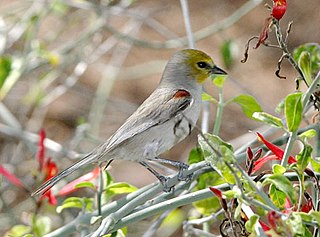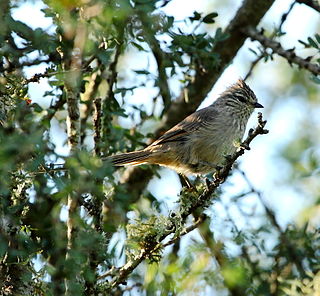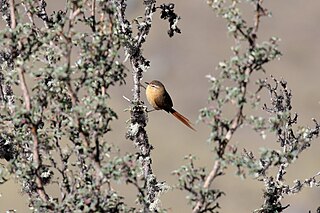
The bushtits or long-tailed tits are small passerine birds from the family Aegithalidae, containing 13 species in three genera, all but one of which (Psaltriparus) are found in Eurasia. Bushtits are active birds with long tails compared to their size, moving almost constantly while they forage for insects in shrubs and trees. During non-breeding season, birds live in flocks of up to 50 individuals. Several bushtit species display cooperative breeding behavior, also called helpers at the nest.

The penduline tits constitute the family, Remizidae, of small passerine birds, related to the true tits. All but the verdin make elaborate bag nests hanging from trees, usually over water.

The tits, chickadees, and titmice constitute the Paridae, a large family of small passerine birds which occur mainly in the Northern Hemisphere and Africa. Most were formerly classified in the genus Parus.

The marsh tit is a Eurasian passerine bird in the tit family Paridae and genus Poecile, closely related to the willow tit, Père David's and Songar tits. It is a small bird, around 12 cm (4.7 in) long and weighing 12 g (0.42 oz), with a black crown and nape, pale cheeks, brown back and greyish-brown wings and tail. Between 8 and 11 subspecies are recognised. Its close resemblance to the willow tit can cause identification problems, especially in the United Kingdom where the local subspecies of the two are very similar: they were not recognised as separate species until 1897.

The great tit is a passerine bird in the tit family Paridae. It is a widespread and common species throughout Europe, the Middle East, Central Asia and east across the Palearctic to the Amur River, south to parts of North Africa where it is generally resident in any sort of woodland; most great tits do not migrate except in extremely harsh winters. Until 2005 this species was lumped with numerous other subspecies. DNA studies have shown these other subspecies to be distinct from the great tit and these have now been separated as two distinct species, the cinereous tit of southern Asia, and the Japanese tit of East Asia. The great tit remains the most widespread species in the genus Parus.

The parrotbills are a family, Paradoxornithidae, of passerine birds that are primarily native to East, Southeast and South Asia, with a single species in western North America, though feral populations exist elsewhere. They are generally small birds that inhabit reedbeds, forests and similar habitats. The traditional parrotbills feed mainly on seeds, e.g. of grasses, to which their robust bill, as the name implies, is well-adapted. Members of the family are usually non-migratory.

The bearded reedling is a small, long-tailed passerine bird found in reed beds near water in the temperate zone of Eurasia. It is frequently known as the bearded tit or the bearded parrotbill, as it historically was believed to be closely related to tits or parrotbills. Today it is known to lack close relatives and it is the only species in the family Panuridae.

Ovenbirds or furnariids are a large family of small suboscine passerine birds found from Mexico and Central to southern South America. They form the family Furnariidae. This is a large family containing around 315 species and 70 genera. The ovenbird, which breeds in North America, is not a furnariid – rather it is a distantly related bird of the wood warbler family, Parulidae.

The long-tailed tit, also named long-tailed bushtit, is a common bird found throughout Europe and the Palearctic. The genus name Aegithalos was a term used by Aristotle for some European tits, including the long-tailed tit.

The Carolina chickadee is a small passerine bird in the tit family Paridae.

The wrentit is a small bird that lives in chaparral, oak woodlands, and bushland on the western coast of North America. It is the only species in the genus Chamaea.

The verdin is a species of penduline tit. It is the only species in the genus Auriparus and the only representative of the old world family Remizidae to be found in North America.

The chestnut-backed chickadee, formerly Parus rufescens, is a small passerine bird in the tit family, Paridae.

The weebill is a species of bird in the family Acanthizidae. It is an insectivorous passerine that is found throughout mainland Australia. At 8 to 9 cm long, it is Australia's smallest bird. It was originally described by John Gould in 1838, and four subspecies are recognised. The weebill's plumage is nondescript, with olive-grey upperparts and paler, more yellowish underparts. It grades from more brownish plumage in the southern regions of Australia to more yellow in tropical areas.

The plain-mantled tit-spinetail is a small passerine bird of South America in the Furnariinae subfamily of the ovenbird family Furnariidae. It is found in Argentina, Bolivia, Chile, and Peru.

Tit-spinetails are small passerine birds of the genus Leptasthenura, belonging to the ovenbird family Furnariidae. They are found in South America, particularly the southern and Andean parts of the continent. They are somewhat similar to birds of the tit family in their shape and feeding behaviour, hence the first part of their name. The "spinetail" part of their name refers to their long, pointed tail feathers. Tit-spinetails have short rounded wings, short pointed bills and are mainly brown in colour. Their nests are built in holes or in the old nests of other birds.

The tufted tit-tyrant is a species of bird in the tyrant flycatcher family Tyrannidae. This species is found in western South America; its range stretches from southern Colombia south along the Andes mountains to Tierra del Fuego. It prefers to live in upper montane forests and shrublands; however, it is a habitat generalist and can be found across a wide range of ecosystems. The tufted tit-tyrant has three subspecies, including the nominate subspecies Anairetes parulus parulus, A. p. aequatorialis, and A. p. patagonicus, and is very closely related to the Juan Fernández tit-tyrant. It is very small with a distinctive and conspicuous crest. The bird's head is black overall with white supraloral and postocular stripes. Its dull grayish-brown back contrasts with its white throat and breast that are covered with black streaks and pale, unmarked yellow underbelly. There are few noticeable differences in plumage between the subspecies. It is a vocal flycatcher with a broad repertoire of songs.

The tufted tit-spinetail is a species of bird in the Furnariinae subfamily of the ovenbird family Furnariidae. It is found in Argentina, Brazil, Uruguay, and possibly Paraguay.

The tawny tit-spinetail is a species of bird in the Furnariinae subfamily of the ovenbird family Furnariidae. It is found in Argentina, Bolivia, and Peru.

Des Murs's wiretail is a small passerine bird of southern South America which belongs to the ovenbird family Furnariidae. Molecular phylogenetics places it within the Synallaxinae and indicates that the genus diverged from the Leptasthenura about 14-15 million years ago.



















